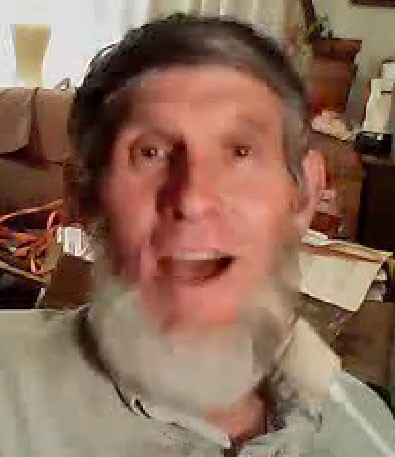Les Thompson wrote an e-book about developing the voice. Here are some excerpts I thinks will be helpful.
“I didn’t arrive on earth with a perfect voice … no one does! Our natural pitch is set at birth and other physical aspects are present for proper breathing and voice production. But there are influences from our parents and our social group that will affect the way we develop our speech and our voice.
(And remember, singing is just sustained speech. Do you have an urge to sing?)
... what’s stopping you?
Many may be telling you that you can’t do it, but the same people
would say that a 4-hour work week is unachievable as well.
….would beg to differ! However, you have to learn how to keep to the blueprint and follow the rules that work.
Therefore, self-motivation is the fuel that will drive your self-development, which in turn will propel you forward towards your goal…It all starts with you!
Motivation comes from within ourselves.
Others can prod and stimulate our journey along the path to achievements, but we have to be able to dare to dream!
I became a broadcaster and journalist by pushing aside my technical college qualifications and my then adequate salary in telecommunications at the age of 21—against a myriad of ‘naysayers’ strongly advising me not to follow my dream— to begin a radio career.
It’s a very important decision for anyone; to embark on an unknown, uncertain path that could substantially affect your future, especially if you have gained qualifications for something else and found that your chosen career is not fulfilling. For that reason, you need to become introspective—question yourself and become certain of what you really want from life.
Over and over again, I have found that people who enjoy what they do are the most successful in the long term. Hence, the most useful motivational advice for people of any age is dare to dream!
Self-motivation doesn’t end there; you must visualise where you are headed, imagining yourself in your chosen role and in reaching that goal. And be prepared to do that mental exercise every day until you have reached where you want to be. Then reset your goal for another few years.
Each time it’s essential that you plan the ‘how to’ steps in order to get to each goal that you set.
…..The first step is to practice using our diaphragm. ……the odd-looking skeletal muscle that’s located just beneath the ribcage and which will force our abdomen outwards when we breathe in deeply. This movement by the parachute-shaped diaphragm forces the air that we breathe into our lungs to power our voice as we breathe it out and speak.
It’s important to develop this method of breathing to produce enough air to produce our speaking voice.
Singers are taught how to use it to control their voices.
The basic exercise to train ourselves to use the diaphragm is as follows:
Standing straight, but relaxed, we first breathe in (inhale) deeply through our nose, placing a hand on our abdomen to feel what is happening to the diaphragm.
Breathe in deeply through your nose and you will feel the diaphragm pushing out your stomach.
Note: If this doesn’t happen, you’re not inhaling deeply; try again.
After you feel your stomach has extended, breathe out (exhale) slowly through your mouth
and you will feel your stomach return to normal. These effects are caused by the action of the
diaphragm below the ribs above the abdominal cavity. What it does is push enough air into
your lungs so that you can produce a rich voice as you speak, powered by that air in your
lungs. It must not be forced; if you do the exercise regularly you will begin to produce your
breathing and your voice in a totally relaxed, natural manner. This method of breathing
provides a resonant voice that is natural and pleasant to the ear. It does not really change the
pitch of a voice, but because it is full, it sounds somewhat deeper than a voice produced
from the throat area.
EXERCISE 1: BREATH CONTROL.
(The purpose of the exercise – which can be repeated through the day whenever you’re alone – is to learn how to breathe using our diaphragm so that we will speak our words and project them with sufficient breath to finish a sentence and to be heard clearly by people listening to us.)
Imagine how a person, who has just been running very fast and needs to speak immediately,
sounds. He is out of breath and as much as he wants to speak clearly his words are unable to
be understood because he is still gasping for breath.
So, like singers, we must learn to breathe using our diaphragm, the muscle that is located at
the bottom of the human rib cage. If we only use short breaths whilst speaking we end up
sounding as though we are speaking from our throats with no resonance to our voice.
The Exercise:
BREATHE IN DEEPLY THROUGH THE NOSE.
AND THEN COUNT OUT LOUD, AS YOU BREATHE OUT THROUGH THE MOUTH.
So here we go…
TAKE A VERY DEEP BREATH through your nose alone and feel your stomach swell.
Now, COUNT OUT LOUD THESE NUMBERS
SLOWLY AND DELIBERATELY, WHILE BREATHING OUT through your mouth:
1, 2, 3,4, 5,6,7,8,9,10
PAUSE VERY BRIEFLY & TAKE ANOTHER QUICK , top-up BREATH and continue
counting WHILE BREATHING OUT:
11,12,13,14,15
TOP UP WITH ANOTHER QUICK BREATH and continue counting WHILE
BREATHING OUT:
16,17,18,19,20
REPEAT this exercise ten times.
Find out what else Les has to teach by going to:
http://lesthompson.tv/

Catch you next time.
Jay























![His Butler's Sister [VHS]](https://images-na.ssl-images-amazon.com/images/I/512R1QQVWWL._SL500_SS140_.jpg)
